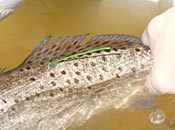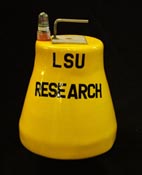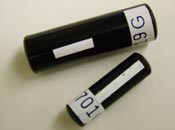Researchers
from Louisiana State University (LSU) are teaming up with
the Louisiana Department of Wildlife and Fisheries (LDWF)
for a study on the movement patterns of spotted seatrout in
Calcasieu Lake. The two-year study will begin May 2007 and
roughly 120 adult spotted seatrout will be outfitted with
acoustic transmitters or “pingers.”
 All
fish with acoustic transmitters will be marked with a yellow
dart tag below the dorsal fin that states “LSU-REWARD-PLEASE
RELEASE.” Fishermen who catch fish with this tag should
release the fish alive and call 1-800-891-3977 to report the
tag number and where and when the fish was caught. It is vital
that these fish be released alive so that researchers can
continue to collect movement data.
All
fish with acoustic transmitters will be marked with a yellow
dart tag below the dorsal fin that states “LSU-REWARD-PLEASE
RELEASE.” Fishermen who catch fish with this tag should
release the fish alive and call 1-800-891-3977 to report the
tag number and where and when the fish was caught. It is vital
that these fish be released alive so that researchers can
continue to collect movement data.
The tag number
is given at both ends of the tag. An example of an LSU tag
number is “LT166001.”
Fishermen who provide
recapture information and release the tagged fish alive will
receive a Louisiana Sport Fish Tagging Program hat and T-shirt,
and be entered in an annual drawing for GPS units and cash
prizes of up to $500.
An array
of receivers also will be placed throughout Calcasieu Lake
to “listen” for fish with transmitters. Receivers
will be placed on channel markers in the Calcasieu Ship Channel
and on buoys in the main body of the lake. Boaters and fishermen
should not tamper with or moor to the buoys.
The Coastal Conservation
Association (CCA) and LDWF also tag fish in Calcasieu Lake.
These dart tags are placed in the same location on the fish,
but have different text on them.
 Research
Goals
Research
Goals
A better
understanding of movement and seasonal migration patterns
of spotted seatrout is critical for effective management of
this species. The study will address questions such as: Do
fish leave Calcasieu Lake and move offshore? If so, do they
return and when? Where do fish spawn and over-winter? Do migration
patterns differ by size and sex?
In addition to
exploring seasonal migration patterns, this study will examine
how fish use different habitat types and change their behavior
when their environment changes. The degree to which and how
spotted seatrout use natural and artificial oyster reefs also
will be evaluated.
Artificial reefs
are often assumed to act as beneficial habitat for spotted
seatrout, but few studies have compared habitat use on natural
and artificial reefs to confirm this notion. Some questions
that will be addressed about behavior include: Do fish move
to deeper waters or offshore for refuge during storms/fronts
or when water temperatures peak in the summer? How do fish
move in response to seasonal changes in temperature and salinity?
Is there more feeding activity under conditions of increased
tidal flow and decreased turbidity? Does fish movement closely
follow prey distributions, such as shrimp? And, are large,
old females or “sows” more solitary than smaller
females and males?
 To
answer of all of these questions, researchers will use acoustic
telemetry. This involves surgically implanting fish with an
acoustic transmitter below the stomach that sends out a sound
ping. When a fish carrying a transmitter passes within the
detection range of a receiver (200 to 300 yards), the receiver
records the fish identification number and date and time of
the detection.
To
answer of all of these questions, researchers will use acoustic
telemetry. This involves surgically implanting fish with an
acoustic transmitter below the stomach that sends out a sound
ping. When a fish carrying a transmitter passes within the
detection range of a receiver (200 to 300 yards), the receiver
records the fish identification number and date and time of
the detection.
While this study
of movement patterns is focused only on Calcasieu Lake, a
system renowned for its large trophy trout and also a hot
topic because of the recent change to more stringent fishing
regulations, this particular project is part of a larger state-wide
study aimed at better understanding stock structure and characteristics,
seasonal migration and habitat use of spotted seatrout.
A volunteer
recreational angler tagging program (CCA, LDWF) is one part
of this larger study. Data from this tagging program provides
important scientific information, collected from recreational
anglers, on movements and stock characteristics (stock size,
mortality and growth). Fishermen wanting to participate in
the tagging program should call 1-800-891-3977 or email fishtags@wlf.louisiana.gov
for more information.
The research
project is partially funded by a U.S. Fish and Wildlife Service
Sport Fish Restoration grant.